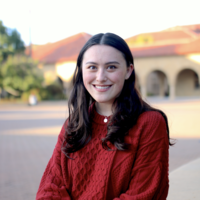IR Honors Students

Isabel Sydney Blum
Powering Europe: Financial Incentivization for Solar Photovoltaic Development
Amidst the urgent call for the transition to a net-zero economy, the European Union stands at the forefront of sustainable energy solutions, notably through innovations in solar photovoltaic (PV) technology and development. Across EU member states, a diverse array of national policies uniquely shape the trajectory of solar PV markets. How do different policy frameworks drive variation in solar PV capacity and market development across the European Union? By undertaking process-tracing case studies of Germany, Spain, and France, this thesis explores the intricacies of solar PV governance amidst the backdrop of shifting energy market landscapes. Initial findings highlight feed-in-tariffs as the most successful policy tool when information asymmetry is accounted for, particularly in stimulating investment and competition. Well-designed feed-in-tariffs offer regulators the flexibility and adaptability to balance support for market development while avoiding excessive policy costs. These findings offer essential insights into effective and ineffective policy design, its impact on market dynamics, and implications for solar PV proliferation, thus informing future research and policymaking efforts.
Thesis Advisor: Professor William Barnett

Kate Bradley
Combat in the Commanding Heights: Gauging Impacts of China's Rare Earths Monopoly on US Energy Security
Metals are the fuel of the future. Rare Earth Elements (REEs), in particular, are a group of 17 metals crucial to EVs and wind turbines because of their unique magnetic properties. In the late 1980s, China began to refine Rare Earth Metals aggressively. A decade later, they dominated global production and now account for 80-90% of REE production. Given the necessity of REE-enabled technologies, it is widely assumed that China’s monopoly over REE production is detrimental to the US’s long-term energy security. However, this hypothesis has not been empirically verified, nor has its magnitude been measured. This thesis aims to quantify the US-China REE supply chain reliance. First, I investigate the performance of REE-reliant US companies during supply shocks. Next, I assess these companies for four key factors indicating supply chain reliance. This reveals which, if any, of these factors have historically dictated performance most. The findings of this study are useful to those who wish to better understand the resource-energy security nexus and the mechanisms of supply chain reliance.

Isa Calero Forero
The Anti-Gender Movement: Impact of a “Gender Ideology” Moral Panic in the Colombian Peace Accord Plebiscite
This study is an expansion of research which aims to understand the impact of the Anti-Gender Movement’s narrative of gender ideology on the Colombian peace accord plebiscite in 2016. The Colombian plebiscite in 2016 was a vote for Colombians to decide if they should accept the peace accord between the government and the guerilla group FARC-EP, in which, with 50.2% of the votes, ‘No’ won. Previous studies have named the narrative of an inclusion of a “gender ideology” as a factor that created opposition to the accord, yet more research is needed to understand why and how it gained traction. Thus, this research seeks to answer the question: How did the narratives surrounding ‘gender ideology’ and the Colombian peace accord shape the discussions about the intended purpose and impact of the accord, and ultimately impact their decision in the peace accord plebiscite? To answer this question, this research will take a mixed methods approach consisting of (1) in-depth interviews with members of political parties that played a role in the construction and revision (after the plebiscite) of the peace accord, including both those who supported it, and those who opposed it, and (2) and short survey polling general knowledge on the “gender ideology” in this political instance, and using a conjoined experiment to identify the factors that most garner opposition in policies regarding language referring to sexual orientation or the LGBTQI community. These methods will provide insight into what narratives were most prevalent in regard to ‘gender ideology’ and how they shaped the perception of the accord. This research will contribute to a growing field that is looking towards the strategies and impact of the Anti-Gender movement, as well as how and why their narratives have been able to gain traction in political decisions.
Thesis Advisors: Professor Beatriz Magaloni and Professor Anna Gryzmala-Busse

Irmak Ersoz
Development Through the Looking Glass: Predictive Modeling Development Project Performance
In 2022, $210.6 billion was donated as official development assistance through bilateral or multilateral channels to a multitude of issue areas and country contexts. While development and humanitarian organizations work to address pressing challenges in turbulent political and economic contexts, the humanitarian funding gap persists due to the interactions of poorly designed projects and unprecedented increases in armed conflict, democratic decline, and economic crises. Is development assistance doomed, or can structural problems within development projects be pinpointed and addressed before projects are implemented? And does governance play a role in the performance of these projects?
While many development scholars have investigated this question through data analysis and case studies, there has been little to no consensus on what makes development projects fail. However, the rise of machine learning in the past years has provided this field with new tools to utilize project evaluation data at a large scale and find patterns between successes and failures within development projects, using these to predict the performance of projects in the future.
In my research, using machine learning and an experimental survey against human judgment, I built a predictive model that attempts to predict the performance of development projects. I used project information spanning over 60 years combined with governance indices spanning from public sector performance to the rule of law to understand whether project characteristics, governance levels, or both influence the performance of development projects. I found that a model that incorporates governance indicators can predict project performance significantly more accurately compared to a model that doesn’t incorporate governance measures, demonstrating the difference a holistic understanding of governance can make for projecting development outcomes.
This rudimentary predictive modeling exercise shows that machine learning can point out patterns of success and failure among a vast corpus of development projects, pointing out policy and project design levers that can prove useful to development professionals as aid is modernized. Ultimately, this thesis shows how these new data science tools can be translated into meaningful contributions to development policy.
Thesis Advisors: Professor Adam Bonica and Professor Jeremy Weinstein

Hannah Marie Freeman
China’s nuclear policy poses an interesting puzzle: the state maintains a limited nuclear arsenal that they frame as for use solely in response to a first nuclear attack, something that has remained consistent since the inception of the state’s nuclear program in January 1955. At the same time, despite a declared opposition to parity and engaging in arms races, the state has pursued military modernization, including the significant expansion of nuclear forces. Other issue areas are characterized by markedly less continuity of policy: once publicly opposed to nuclear nonproliferation, the state has since become a party to the Treaty on the Non-Proliferation of Nuclear Weapons (NPT), the Comprehensive Test Ban Treaty (CTBT), and Partial Test Ban Treaty (PTBT), but in 2020, declined to participate in trilateral nuclear arms reduction talks with the United States and Russia and has begun significant new construction at Lop Nur, the state’s only nuclear testing site. What in China’s external strategic environment shapes the state’s nuclear weapons policies? In the context of an increasingly hostile external environment characterized by great power competition and both regional and global tensions, understanding what shapes the continuities and discontinuities of the state’s nuclear policy is paramount to the formulation of good policy globally by state and civil society actors alike that seek to make the world safer and more secure.
Thesis Advisor: Dr. Thomas Fingar

Nina Iskandarsjach
The Wagner Scramble for Africa: assessing the effectiveness of Russian intervention in the African Sahel
For my honors thesis, I am analyzing the impact of Wagner Group involvement on the current conflict in Mali. Specifically, I am using a counterinsurgency framework to assess the effectiveness of the Wagner Group's intervention in Mali. My thesis will combine a geospatial analysis with a qualitative analysis of an assortment of other sources, including reports from NGOs and international institutions, Wagner and jihadist propaganda, and local news reports.
Thesis Advisor: Dr.Bertrand Patenaude

Charlie Kogen
From Évian to Jackson-Vanik: US Policy toward Jewish Immigration in the Mid-20th Century
Both at home and abroad, people have often characterized the United States as a “nation of immigrants,” but this rosy sentiment belies a more complex picture. Many factors have affected the flow of immigration to the US, including international affairs, domestic political developments, and the nature of the political actors at play. My thesis examines the US government’s response to two waves of migration that share several commonalities: emigration from Nazi Germany in the 1930s, and emigration from the Soviet Union in the late 1960s and early 1970s. Both groups of emigrants experienced institutional difficulty departing their countries of origin, countries with whom the US had strained relations at the time, and most significantly, both groups were predominantly Jewish. The US policies in each era, however, reached markedly different high points. The Évian Conference of 1938, organized by President Roosevelt and attended by diplomats from over 30 other countries, attempted to multilaterally loosen restrictive immigration policy that the US government itself refused to change, while the Jackson-Vanik Amendment to the 1974 Trade Act sought to unilaterally loosen Soviet emigration policy through favorable trade relations. By analyzing primary source documents from both periods (as well as between the two periods) concerning the decision-making of government officials, popular domestic sentiments, the advocacy of Jewish non-governmental organizations, and the attitudes of the personalities involved, I hope to put these two eras of policy in conversation with one another, helping to identify and evaluate the factors that led to such different responses from the US government across time.
Thesis Advisor: Professor Amir Weiner

Anuka Mohanpuhr
Regulating and Preventing the Spread of Fake News Online: Comparing Strategies in the EU and Germany
The rise of fake news and disinformation campaigns that spread rapidly online is cause for worldwide concern, especially since fake news polarizes public opinion, promotes violent extremism and hate speech, and, ultimately, undermines democracy and the social fabric that holds together our communities. The United States, where constitutional commitment to free speech makes regulation of online platforms difficult, relies almost exclusively on self-governance and community standards adopted by social media platforms. The European Union, on the other hand, has taken a more proactive approach by enacting transparency standards and passing legislation that imposes high fines on those social media companies that do not promptly remove content that has been flagged as fake. Given the different approaches to regulating the spread of fake news on social media adopted by the U.S. and EU members, such as Germany, I use a survey to evaluate the response of individuals in the U.S. to different regulatory approaches. My survey experiment tests the efficacy of different labels and other tools across a variety of fake news topics to help improve our understanding of potential new legislative approaches. The survey has been approved by Stanford’s Institutional Review Board and will be distributed to a representative sample of 3,000 users in January 2024.
Thesis Advisor: Professor Michael Tomz

Bailey Nicolson
Evaluating the Effects of OPEC Membership for Oil Nationalized Countries
Academic literature and scholarship surrounding the Organization of the Petroleum Exporting Countries (OPEC) and the effects of oil nationalization evaluate the two separately. Econometric analyses debate OPEC’s ability to collude prices according to dominant cartel theory and question OPEC’s relevance economically. Studies of the effects of natural resource nationalization understand regional implications separated from the socio-political implications of membership in OPEC. Given the aforementioned significance of OPEC as well as the importance of understanding domestic effects of oil nationalization, my research bridges the gap in the literature: amongst countries with nationalized oil programs, how has membership in OPEC affected variables of political accountability? In my thesis, I will evaluate two sets of two countries on variables related to political accountability before and after oil nationalization relative to dates the country joined OPEC. I incorporate primary and secondary materials, including historical accounts, interviews, and various archives to understand the trajectory of a country before nationalizing their oil program and the implications of the nationalization event on political accountability. This contextualizes the relevance of sovereignty over natural resources and contemporary debates surrounding the impact of OPEC for global petroleum markets.
Thesis Advisor: Professor Amanda Kennard

Ria Reddy
Striking the Atom: Exploring the Consequences for Perpetrators of Preventive Strikes on Nuclear Ambitions Throughout History
My thesis aims to explore and analyze the consequences confronted by actors who have pursued preventive action against nuclear programs historically. The legal landscape surrounding these actions, along with the broader notion of self-defense within international law, remains ambiguous. As a result, the consequences the attacker faces for such strikes exhibit some variability and cannot necessarily be linearly defined. My aim is to examine these consequences to gain a nuanced understanding of the legitimacy of preventive attacks within the non-proliferation regime and the factors that may shield actors from certain repercussions.
Thesis Advisor: Professor Kenneth Schultz